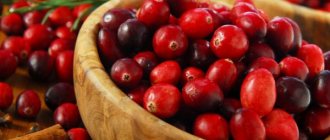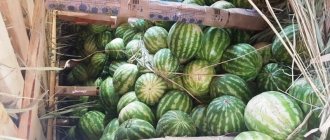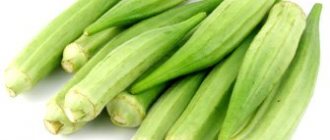Cranberries are valued not only for their taste, but also for their unique composition and medicinal properties. Every season, thrifty housewives think about how to store cranberries correctly, because they help fight many diseases and are a good addition to drinks and meat dishes.
The berries are harvested in September – October
You can save berries for the winter in different ways: from regular freezing to soaking and drying. This article discusses popular storage options at home.
What are the benefits of cranberries?
The benefits of this berry have been proven since ancient times - compotes, jelly and fruit drinks have long been prepared from it in Rus'. It was the first remedy for anemia, to increase immunity and treat colds. Cranberry juice was used to treat fever, scurvy, and to smear ulcers and severe wounds.
Later, it was also scientifically proven that the valuable complex of microelements of this berry helps prevent cancer and helps to survive the fight against radiation sickness. Disorders of the urinary system, weak intestinal muscles, and fungal infections are also treated with cranberries, prescribing them fresh to the patient. Cranberries are indicated after heart attacks and strokes, as the favonoids it contains enhance the production of “good” cholesterol. Doctors also prescribe the use of these berries at the risk of miscarriages, anemia in pregnancy and female bleeding, menopause and the post-operative stage of illness.
Cranberries remove heavy metals and radioactive substances, so they are especially valuable for people in hazardous industries. Iron, cobalt, zinc, potassium, calcium, magnesium, phosphorus, vitamins A, K, C - this is not a complete list of useful microelements contained in this berry.
Benefits and harms of CRANBERRY for the human body?
If your immunity has weakened over the winter and spring, cranberries are an excellent natural remedy for stimulating it. The period of colds also requires vitamin supplements. The berry, mixed with honey, fights fever and ARVI viruses. Cough softens, sore throat goes away from cranberries mixed with honey.
However, the huge amount of organic acids in marsh berries dictates caution in case of liver diseases, gastritis with high acidity in the stomach. Such patients should consult a doctor before treatment with cranberry juice.
How to store cranberries frozen
Before storing cranberries, they must be prepared: this is the only way to achieve maximum benefits and freshness. To do this, berries collected in September-October are carefully sorted from twigs and leaves, and overripe, wrinkled specimens are removed. Rotten, brown, and green cranberries are also isolated. Then everything is washed under running water, dried in a colander and additionally placed on a clean rag to drain the water. After this simple procedure, you can begin storage.
Cranberries are often stored frozen, for example in the freezer. In rural houses and villages, cranberries have long been stored in the cold, for example, in a box located outside a warm home. In modern apartments, this berry is taken out to the balcony and stored frozen.
How to prepare berries?
Before performing any manipulations with cranberries, you need to prepare them in a certain way. First of all, sort out the fruits. Throw aside all leaves, twigs, insects. If wrinkled or too ripe, set aside. You shouldn’t throw them away, because you can make an excellent fruit drink from these berries (see recipe at the end of the article). But white, that is, completely unripe berries, should not be used. Then wash the cranberries thoroughly and dry them on a sieve or tray.
So, having decided which berries are best for long-term storage, we will tell you the most popular and successful ways to store cranberries.
We recommend: How to properly store an open package of coffee beans?
How to store fresh cranberries without freezing
Alternatively, it can be placed in glass jars and stored in the refrigerator. This method provides two options: with and without sugar. In both cases, the berries will not spoil.
You can send a container of cranberries to the balcony, however, if it is not glass. In severe frosts, glass may crack, so it is better to choose a plastic or enamel bucket. Pots made of aluminum and similar metals are completely unsuitable, since when interacting with acid they can serve as a source of severe poisoning.
A cellar or underground is also an option if you have a private house. In this case, in any case, the vitamin complex of the berry will not be affected, thanks to the benzoic acid it contains.
Storage methods at home
The storage conditions for cranberries depend on the availability of space where the winter harvest will be located. For example, in a private house, supplies can be stored in the basement, attic, barn or any other utility room. Residents of apartments usually have only a kitchen, a storage room and a balcony at their disposal (and these are not always available). Therefore, in the second case, the choice of how to store cranberries will not be so great.
When giving preference to one method or another, you need to focus on your capabilities. You should choose the type of preparation (one or several) in which the product will be in the best conditions, thanks to which it will be able to retain its beneficial qualities longer.
Fresh
Fresh cranberries are most beneficial. It contains a maximum of vitamins and minerals that are not lost during long-term storage. For preparations, you should use freshly picked or recently purchased berries that have not been touched by frost.
Frozen berries should be immediately placed in the refrigerator or freezer.
It is necessary to store cranberries without refrigeration and without freezing in a cool, dark room. It is very important that the room is well ventilated. In this case, the berries will not rot and spoil. Benzoic acid will prevent the development of rotting processes in the product and extend its shelf life. In this form, the fruits can be stored for several months.
To properly store cranberries without heat treatment, you should use containers made of ceramic, wood or stainless steel. Enameled cookware is also suitable, but you need to make sure that it is not damaged (cracks, chips, etc.).
Fresh berries must be stirred periodically and checked for spoiled fruits, which are immediately removed from the container.
It is not recommended to use plastic bags for storing cranberries. There is a high probability of condensation forming in them, so the product begins to become damp and moldy. In addition, many polyethylene bags are not intended for storing food, but are used only for industrial and household purposes.
In water
Fresh berries are also used for this type of preparation. They are placed in sterilized glass jars and filled with clean cold water. The water is first boiled and cooled. It is better to take water from a well, borehole or spring rather than from a tap, as it contains chlorine. Or let tap water sit for about 7-8 hours.
For the winter, the jars are put away in a cold place: on a glazed balcony, basement or refrigerator. It is important that the room maintains a low positive temperature.
You can add additional flavor notes to soaked cranberries by adding spices to the water (a few allspice peas, three or four buds of cloves, a little cinnamon). To sweeten the berries, instead of plain water, use syrup in the following proportion: for every 0.5 liters of water, 1 tbsp. a spoonful of sugar and a pinch of salt.
Dried
Another way to store cranberries without refrigeration. Drying allows you to preserve almost the same amount of nutrients in the fruits as in fresh cranberries. At the same time, you can store it longer. You can dry the fruits using an oven or electric dryer, but it is better to use regular fresh air.
The berries are placed on a hard, dry, clean surface (for example, a floor covered with cotton cloth or paper) with good air access. Keep at room temperature until completely dry.
In the oven, the fruits are placed in one layer on a baking sheet covered with parchment and dried at a temperature of 50C for about 6-8 hours. The cranberries must be stirred periodically.
In an electric dryer, the berries are placed on pallets and the temperature is set to 50-55C. It is necessary to stir periodically. It is also important to consider that drying occurs faster on the lower shelves.
In the microwave, cranberries can be dried in 2 minutes, however, they will lose up to 75% of their nutrients.
Dried fruits are stored in dry containers (wooden or glass) at room temperature in a dark place. For example, in the pantry.
Frozen
Cranberries can also be stored in the refrigerator or freezer. At the same time, in terms of usefulness, it will be slightly inferior to fresh berries, however, freezing will extend the shelf life of the product.
Freezing cranberries is very easy. It is enough to pour the dry berries into storage containers and put them in the freezer. To do this, you can use plastic containers for storing food, or special bags with a slider clasp.
The fruits must be dry during freezing so that they retain their crispness. Otherwise, they will freeze to each other and turn into a solid cranberry lump.
With sugar
Sugar is a good preservative. It is often used for preparing winter preparations, including storing cranberries. Sugar can significantly extend the shelf life of berries, however, it significantly reduces their nutritional value. At the same time, cranberries will still be very healthy, but they will retain more vitamins if they are stored without sugar.
There are two popular ways to make sugar preparations:
- Whole fruits are placed in layers in a glass dish or plastic food container. Each layer is filled with approximately 1 cm of granulated sugar. Next, close the container with a tight lid and shake a little. In this form, cranberries are stored in the refrigerator.
- Fresh berries are ground using a sieve, masher, meat grinder or blender (not only whole fruits, but also cracked ones can be used). The resulting puree is sprinkled with sugar in a 1:1 ratio and mixed thoroughly. The mass is placed in glass jars (preferably sterilized), closed with a tight lid and kept at room temperature for 24 hours (so that the sugar is well dissolved). Store cranberry puree in the refrigerator or freezer.
Cranberries sprinkled with sugar
Cranberries pureed with sugar
Canned
Cranberries can be successfully stored in winter after heat treatment. This way it won’t spoil for more than one season. However, it should be borne in mind that a large amount of vitamins is lost during boiling. The product is no longer as healthy as the fresh, dried or frozen version.
For canning, it is recommended to use a recipe for preparing berries in their own juice. In this case, the mass is not brought to a boil, which allows you to preserve a significant part of the beneficial substances. The cranberries are poured into an enamel bowl and placed on low heat. As soon as the berries release juice, they are placed in sterilized glass jars and covered with lids. The jars are kept in a water bath for 15 minutes and rolled up.
Cranberry jam will be an excellent tasty dessert, but it can hardly be called healthy. To prepare jam, you need to pour 1 kg of fruit with 2 glasses of water and cook over low heat. When the berries begin to burst, add 5-6 cups of sugar to them. Mix well and cook (stirring constantly) until the mixture thickens to a sufficient consistency. The jam is placed in sterilized glass jars and sealed.
How to store cranberries in water in a jar
This method requires clean water and well-washed dishes. Plastic containers, such as milk or water bottles, that have been washed well are acceptable. For large volumes, enamel pans and plastic buckets with lids are suitable.
The cranberries are washed in cold water and the defects are removed. Everything is poured into a prepared container and filled with cold boiled water. All. Nothing more is needed. The container is sent to a glassed-in loggia, refrigerator or basement. The only condition: the container with water should not freeze. Frozen water after thawing will spoil the berries and the product will be unusable.
Secrets of experienced housewives
Secrets of storing and preparing cranberries from experienced housewives:
- Wash the berries without touching them with your hands so that they do not squash or release juice. Use a sieve.
- Wear gloves when handling cranberries. The juice stains and irritates the skin.
- To determine if a cranberry is ripe, drop it on the floor or table. If the berry bounces like a ball when it falls, then it is fully ripe.
- Pickled cranberries are used during crop preservation. Add a few soaked berries when pickling cucumbers or cabbage. They will give vegetables a piquant sweet-sour taste.
- When soaking, use well or spring water. If this is not the case, then use tap water after boiling it.
- You can make a delicious fruit drink from cranberries. Mix 300 g of berries and 140 g of sugar, add filtered water, boil over low heat, wait until the drink cools. If you use frozen cranberries, let them melt on their own. Add ginger, honey or lemon.
- Place cranberries in a meat or vegetable dish. This will add some spice to it.
- To prevent colds, pass 0.5 kg of cranberries and lemon through a meat grinder, add honey. Wash the mixture with hot tea.
Read more ► How to preserve melon for the winter or at least until the New Year?
How to store pureed cranberries
Mashed berries are very tasty, do not require cooking and can replace jam. This delicacy is indispensable for colds or flu, so it must be prepared in case of illness.
So, the cranberries are washed, spoiled berries and branches are removed. Place in a colander on an old cloth. Next, it is placed in a large, clean container and mixed with sugar at a ratio of one to one. All contents are scrolled through a meat grinder or crushed in a blender. Place everything in small jars, cover with lids and put in the refrigerator for storage. From this raw jam you can make jelly, fruit juice, or prepare a filling for a pie or cupcake.
Collection time
Although nature has endowed vitamin-rich berries with the ability to overwinter on bushes under the snow, the percentage of acidity after wintering decreases so much that spring cranberries cannot be stored for long. Having accumulated sugar, it loses its valuable pectins. Because of this, in culinary processing it is no longer so tasty and piquant.
The berries collected in summer are hard, bitter and not fully colored. Although unnatural ripening occurs over time, the summer fruit does not have the required juiciness. Just as there is no cranberry flavor, beloved by many connoisseurs. Therefore, traditionally, berries picked in September-October are prepared for the winter.
By that time, it is filled with earth juice and acquires its purple hue. However, there are enough microorganisms on the skin of autumn cranberries that, under suitable conditions, will give rise to fermentation. Therefore, previously, the autumn berry harvest was simply sorted and scattered on a dry surface in a thin layer for ripening.
Ripening rules
Knowing about the ability of cranberries to ripen and the dependence of the duration of storage on the content of natural preservative organic acids in the berry, we preferred to take it slightly unripe and hard. Such fruits were less wrinkled during transportation. And she matured already at home.
Before sending cranberries for long-term storage, they are kept in a dry room at room temperature for one or two weeks, laid out in cardboard boxes or wicker baskets lined with a clean cloth along the bottom. This applies to slightly unripe cranberries. If completely white berries were picked, nothing good will come of the idea.
Important! To speed up the ripening process, it’s a good idea to add a sweet apple or red tomato to each container. These fruits emit ethylene, a gas that acts as a catalyst for ripening reactions.
Collection and preparation of cranberries for storage
Cranberries are harvested three times during the year:
- in September - cranberries are just beginning to ripen, they are quite sour. But sorting and washing it is much more convenient than the later one;
- after the first frosts - the berries are translucent, maximally ripe, juicy, sweet;
- in early spring - the berry that has wintered under the snow is the sweetest and most aromatic. But it loses a lot of vitamin C and is not suitable for long-term storage.
For long-term storage, cranberries must first be prepared. The berries are separated from leaves and debris and sorted, eliminating spoiled and crushed ones. Green, white, unripe, rotten cranberries are thrown away. Selected berries are carefully washed and dried on a kitchen towel, sieve, tray or other flat surface. Crumpled and overripe cranberries are immediately used for fruit drink or jam.
After harvesting cranberries, the berries need to be sorted, washed and dried.
Recipes using cranberries
Cranberries in their own juice
Method 1. Selected berries are sorted by size. Large berries are placed in a saucepan (measure the quantity in glasses). The small ones are kneaded into porridge, the resulting mass is heated a little and the juice is squeezed out. Add 4-5 glasses of juice to 10 glasses of cranberries. The mixture is heated, without bringing to a boil, and placed in dry, hot, sterilized jars. Then cover the jars with lids and sterilize them in a water bath (liter - 15 minutes, half-liter - 10 minutes), after which they are rolled up, turned over, and wrapped.
Method 2. Selected, ripe cranberries are placed in a saucepan and heated over low heat or a water bath until the berries give juice. The resulting mass is placed in dry, hot, sterilized jars, sterilized and rolled up.
Method 3. Fill clean, dry jars tightly with cranberries, while simultaneously placing them in a water bath to heat. When the berries begin to release juice and decrease in volume, the jars are refilled with cranberries. Berries for replenishment are taken from any one jar, which is heated along with the rest. After the berry level stops decreasing, keep the jars in a water bath for another 10 minutes and seal.
Jars of cranberries prepared in this way are stored in a cellar or other cool, dark place.
Jam
Boil 1 kilogram of selected ripe cranberries in 2 glasses of water until the skin of the berries bursts. The uncooked berries floating on top are taken out with a slotted spoon, crushed and placed with the rest. Then add 7 cups of sugar, stir, bring to a boil and cook for 17-20 minutes. If a drop of syrup does not spread on the plate, the jam is ready. It is laid out hot in heated sterile jars, rolled up, and turned over.
Jam
Option 1. Beat 250 g of orange juice in a blender with 1 kg of cranberries until smooth. Add 3 kg of sugar, bring the mixture to a boil and cook, stirring, over low heat for about 1 hour. The cooled jam is poured into sterilized jars.
Option 2. Place 1 kg of cranberries in a colander, blanch them to soften in 2 cups of boiling water for several minutes, and remove. Then 1.5 kg of sugar is poured into the water to obtain a syrup, berries are added to it, brought to a boil and cooked until tender.
Option 3. Add 1 kg of cranberries to 1.5 kg of sugar and leave until the juice is released. Pour the juice into another pan and bring to a boil. Place cranberries into boiling syrup and cook for no more than 5 minutes. The finished jam is placed in a sterilized container and covered with a lid.
How long do cranberries last?
The shelf life of well-prepared high-quality raw materials depends on temperature, humidity, and exposure to light. Fruits planted for the winter in any way should be protected from direct sunlight. Average shelf life of cranberries under various conditions:
- in the refrigerator at a temperature range from +1 to +5 °C – about 30 days;
- frozen, without thawing and re-cooling – up to 12 months;
- fresh, in a ventilated cellar or basement - from 60 days to six months;
- soaked, in a cool room or refrigerator - from 6 to 10 months;
- dried, when stored in a dry, dark place - up to 3 years.
Advice! It is useful to save a small amount of soaked or frozen berries until the vegetable canning season. In marinades and pickling, they act as an additional preservative and also enrich the taste.
Interesting facts about cranberries
- The higher the acidity of the cranberries, the longer they will be stored.
- You can also pick or buy slightly unripe berries - cranberries can ripen later. If for some reason you want to speed up the process, you can put a tomato or apple in a container with cranberries. The ethylene they release will affect the berries. However, we must remember that the best berries are those collected in late autumn, dark red or purple in color.
- Cranberries are harvested several times a year. The first time was during the golden autumn. The second is before winter, when the temperature drops below zero and the first snow falls. The third is in the spring, after the snow has melted.
- Cranberries are 90% water.
- It prevents urinary tract infections, reduces the risk of cardiovascular diseases, slows the progression of malignant tumors, and improves vision.
- Cranberries are rich in vitamin C, B, PP, K1, potassium, magnesium, iron, calcium and phosphorus, as well as fiber and antioxidants.
- Regular consumption of cranberry juice or fruit drink relieves depression and stress.
- One cup of fresh berries is equivalent to half a cup of dried cranberries.
Preserving Pickled Cranberries
To prepare, you will need ordinary water and containers suitable for storage (jars, bottles, containers). A prerequisite when choosing storage containers is tightness.
Clean and dried fruits are placed in a container. Then pour boiled, cooled water. For storage they are left in a cold place (cellar, refrigerator) at a temperature no higher than 6-8 degrees.
There is a second option - it is identical to the previous one, only you need to fill it with a sugar solution instead of water. For one kilogram of cranberries there is one spoon of sugar and a little salt. Depending on preferences, favorite spices are added. The disadvantage of this option is that the berry absorbs water in such conditions, which slightly affects the original taste. The fruits will lose their hardness and crispness, but will not lose their beneficial properties.










